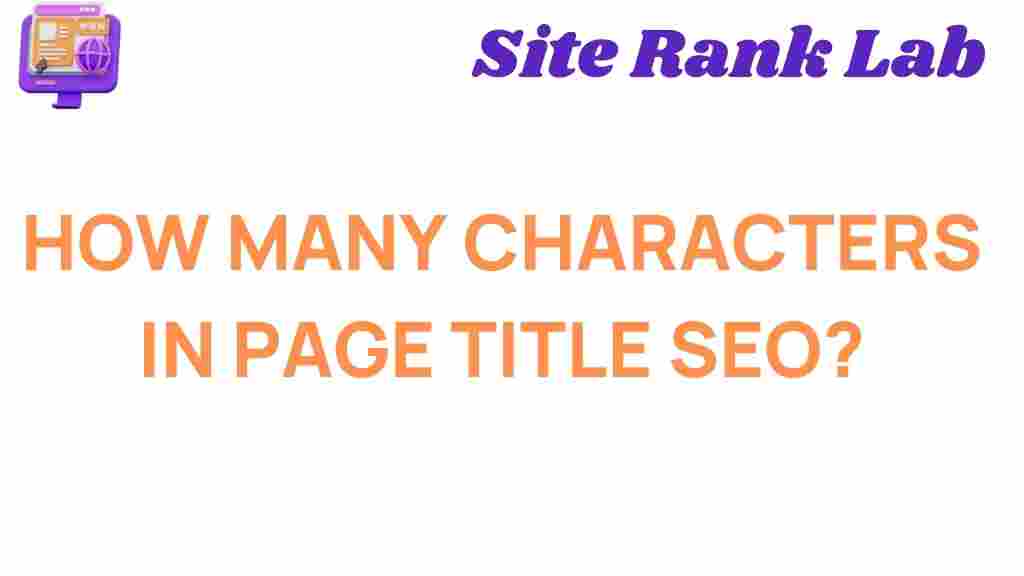Unveiling the Secrets: How Many Characters Should Your SEO Page Title Have?
In the realm of search engine optimization (SEO), the page title is a critical element that can significantly impact your online visibility and user engagement. Understanding the optimal character limit for your SEO page title is essential for maximizing your content’s effectiveness in search results. This article will delve into the character limitations of page titles, the importance of crafting them effectively, and tips to enhance your digital marketing strategy.
The Importance of SEO Page Titles
Your page title is not just a label; it is a powerful tool that plays a crucial role in the following areas:
- Search Engine Ranking: Page titles are one of the primary ranking factors used by search engines to determine the relevance of your content.
- User Engagement: An engaging title can attract clicks, encouraging users to visit your site over competitors.
- Branding: A well-crafted title can enhance brand recognition and convey your site’s purpose effectively.
Understanding Character Limits for SEO Page Titles
When it comes to creating effective page titles, there is a consensus among SEO experts regarding the character limit. Generally, the optimal length for an SEO page title is between 50 to 60 characters. This range is recommended for several reasons:
- Search Engine Display: Google typically displays the first 50-60 characters of a page title in search results. Exceeding this limit may result in your title being truncated, which can lead to loss of important information.
- User Experience: A concise title is easier for users to read and understand quickly, improving the likelihood of clicks.
- Keyword Placement: Keeping your title within this character limit allows you to incorporate essential keywords without sacrificing clarity.
Step-by-Step Process to Crafting an Effective SEO Page Title
Creating an effective SEO page title involves several steps. Here’s a comprehensive process to follow:
Step 1: Identify Your Primary Keywords
Before crafting your page title, you need to determine the primary keywords that you want to target. Use tools like Google Keyword Planner or SEMrush to discover relevant keywords with high search volumes.
Step 2: Understand Your Audience
Know your target audience. What are they searching for? What are their pain points? Tailoring your title to address these factors will improve user engagement.
Step 3: Keep It Concise and Relevant
Your title should be descriptive yet concise. Aim for clarity and relevance, ensuring that it accurately reflects the content of your page.
Step 4: Include Brand Name (Optional)
If applicable, consider including your brand name at the end of the title. This can enhance brand recognition and trust, especially for established brands.
Step 5: Test Different Variations
Don’t hesitate to experiment with different title variations. A/B testing can help you determine which titles resonate more with your audience and perform better in search results.
Common Mistakes to Avoid When Crafting Your Page Title
While creating your SEO page title, be aware of common pitfalls to avoid:
- Keyword Stuffing: Avoid cramming too many keywords into your title. This can come off as spammy and negatively impact your ranking.
- Vague Titles: Ensure your title is specific and informative. Vague titles can confuse users and diminish click-through rates.
- Ignoring Character Limits: As discussed, exceeding the character limit can result in truncated titles. Always keep your titles within the recommended range.
Troubleshooting Tips for Optimizing Your Page Title
If you find that your page title isn’t performing as expected, consider these troubleshooting tips:
- Analyze Click-Through Rates (CTR): Use Google Search Console to monitor your page’s CTR. If it’s low, reconsider your title’s appeal and relevance.
- Check for Duplication: Ensure that your title is unique compared to other pages on your site. Duplicate titles can confuse search engines.
- Review Competitor Titles: Look at how your competitors are crafting their titles. This can provide insights and inspiration for improvements.
The Role of Title Tags in SEO
Title tags are HTML elements that define the title of a webpage. They are a crucial aspect of SEO and are displayed on search engine results pages (SERPs) and browser tabs. Here’s why title tags matter:
- SEO Ranking Factor: Search engines prioritize title tags when ranking pages, making them essential for effective SEO.
- User Perception: A well-optimized title tag can influence how users perceive your content and whether they click on your link.
- Social Sharing: When shared on social media, the title tag often serves as the default text, impacting how your content is presented.
Conclusion: Mastering Your SEO Page Title for Success
In the world of digital marketing, understanding how many characters your SEO page title should have is fundamental to enhancing your online visibility and user engagement. By adhering to the optimal character limit of 50 to 60 characters, utilizing relevant keywords, and avoiding common mistakes, you can significantly improve your chances of ranking higher in search results.
Ultimately, your page title is a gateway to your content. It is the first impression users have of what you offer, and it can make or break their decision to click through. Invest time in crafting compelling, concise, and relevant titles that align with your audience’s needs, and watch your online visibility soar.
For more insights on SEO best practices, feel free to check out this comprehensive guide. Additionally, you can explore more tips on enhancing your digital marketing strategy through this resource.
This article is in the category SEO and created by SiteRankLab Team
